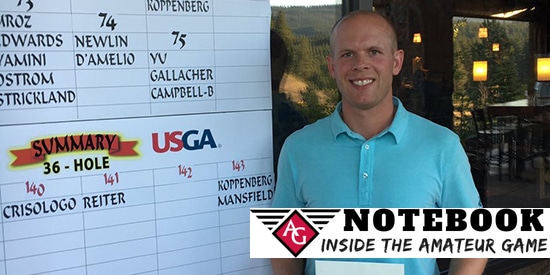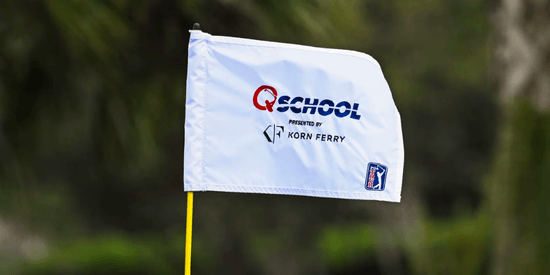Notebook: Koppenberg's golf journey; WATC tales from Dublin
9/7/2018 | by Julie Williams of AmateurGolf.com
see also: U.S. Mid-Amateur Championship, Sand Valley Golf Resort - Sand Valley

Get to know Jake Koppenberg's Mid-Amateur story, plus hear the details behind the U.S. women reclaiming the Espirito Santo trophy
Reaching match play in a U.S. Amateur is a currency that any golfer can understand. Even as the commentators struggled to provide much information on Koppenberg during the telecast that day, friends at home got it.
“People understood what that meant,” Koppenberg said. “I was playing Rickie Fowler, he was the No. 1 amateur in the world. I had maybe not thought about it too much when people started talking about it.”
Koppenberg ultimately lost that match, 6 and 5, but he has been back to the event three times since. Last month at Pebble Beach, Koppenberg, now 31, missed a playoff for match play by a single shot. He stuck around an extra day to “see some great golf and get inspired.”
Follow former Viking and current @WWUMGolf asst. coach Jake Koppenberg in the @USGA Amateur starting today in LA.https://t.co/NbwIEYVhmC pic.twitter.com/DeDefPPqUj
— WWU Athletics (@WWUAthletics) August 14, 2017
Feeling that his game was in a good place after his senior year of college, Koppenberg, an Everett, Wash., native, moved south to Arizona after his 2009 graduation to chase a professional career. It’s a lonely life for players on the cusp. Koppenberg watched too many guys grind on the mini-tours, fail to make it through Q-School in the winter, then come back to do the same grind. The mini-tour arena can often be one without fans, stability or much prize money.
“I just wanted to play more golf,” said Koppenberg, who admitted that the life of an aspiring pro is not exactly what he thought it would be. “I just saw how many cool things were out there for amateurs.”
Koppenberg took second in a one-day Pepsi Tour event late in 2012, won roughly $750 for his efforts, then stepped away from the game for six months. When he realized he would have to wait roughly a year from his last pro start to regain his amateur status, he decided to step away for good. Koppenberg was reinstated in November 2013, played a few small local amateur events around his home in Bellingham, Wash., and has competed in the 2015, ’17 and ’18 U.S. Amateurs since – not to mention other larger amateur events in the Pacific Northwest. Koppenberg was runner-up at last week’s Washington Mid-Amateur.
For the first time in his competitive golf life, he will make two USGA starts in the same calendar year. Koppenberg will play his first U.S. Mid-Amateur in Charlotte, N.C., later this month. Like many players with his background, he views it as his best opportunity to play a major.
“I haven’t performed at USGA events, but there’s still the chance that I can win a USGA event,” he said. “Those opportunities are just not there for the mini-tour guy that doesn’t have status on any of the main tours.”
“Some guys just like a second eye on what they’re doing with their swing and certain shots,” Koppenberg said. “Others just ask how to compete at certain levels and what it’s like when you get into the moment.”
Koppenberg and his wife had their first child in January. In anticipation of growing his family, Koppenberg informally announced on last summer’s amateur circuit that other players probably wouldn’t see him for awhile. But Baby Koppenberg is, as his dad says, “super easy” and a decent sleeper. That opened the door for one of his busiest, but one of his best, summers since he was in college. He often practices late in the day during whatever time he can spare, but it’s a different kind of practice. Without hours to devote to range balls and putting drills – and without the desire to do it – Koppenberg simply plays. It has changed his mindest on the game.
“That’s my advice to younger players, especially on WWU team,” he said. “Get off the putting green, get off the driving range, go play and try to beat your friends and other players who are better than you.”
It’s the driving principle behind Koppenberg’s career in golf.
• • •
BACK TO PEBBLE BEACH: The college season began with a bang last weekend at the Carmel Cup, an event that Vanderbilt has hosted at Pebble Beach since 2011. This year was different considering that the top amateurs were only two weeks removed from playing Pebble Beach for the U.S. Amateur.
Oklahoma won with a 46-under three-day total of 1,034 (the tournament featured the rare play six, count five format). It’s especially noteworthy considering that the Sooners were only 2 under as a team the final day, and very nearly lost their commanding lead. Oklahoma State finished runner-up despite not having U.S. Amateur champion Viktor Hovland in the lineup. He is in Dublin, Ireland, this week representing Norway in the World Amateur Team Championship.
College tournament we're watching this week: The Carpet Capital Collegiate
• • •
HIGH SCHOOL GOLF PARTICIPATION: A LITTLE UP, A LITTLE DOWN: The NCAA published data last week (collected from the National Federation of State High School Associations) showing how high school sports participation has changed over the past five years.
Participation is up considerably for women’s golf – the sport grew 10.9 percent from the 2012-13 season to the 2017-18 season, which shakes out to the addition of about 7,727 golfers. Men’s golf, however went the opposite way as participation declined by 5.6 percent.
How has sports participation changed in high schools over the past 5 years? Growth over 10% for lax, indoor track, fencing, rifle, boys volleyball, boys soccer, girls water polo and girls golf (Data @NFHS_Org). pic.twitter.com/aNG5FEwiYX
— NCAA Research (@NCAAResearch) August 29, 2018
QUOTABLE:
U.S. Senior Amateur champion Jeff Wilson on watching young players at the U.S. Amateur (our in-depth feature on Wilson can be found here):
“These kids are really good now. I’d sit there and watch them on the driving range, up and down the bag, they just hit it hard and then go find it. It’s like they push it up as far, as close to the green as you possibly can. You kind of watch that and go, maybe that is a better way to play. Maybe it is better to be in the rough closer to the green that it is in the fairway, way back.”
• • •
Four questions with…Stacey Collins, who captained the American squad of Jennifer Kupcho, Kristen Gillman and Lilia Vu to victory on Sept. 1 at the Women’s World Amateur Team Championship in Dublin, Ireland. Collins is the Senior VP of Tour Operations at the LPGA, and has served as a USGA championship official and was a nine-year member of the USGA Women’s Committee, serving as chairman in 2015-16.
1. The three-woman American team won the Espirito Santo Trophy for the first time in 20 years. What did that mean to these three college players – and Curtis Cup players – and what does it mean to you being their captain?
These girls, they played together on the Curtis Cup team, they all played Palmer Cup together this summer. My biggest thing this past week was I wanted them to realize how important this week was, and I know that it has been a long summer with competition. . . . All three are going to Q-School this fall for the LPGA, so this is really it, this is their one chance to play on a World Amateur team. So we talked about that, we talked about setting goals and their goal was to win it. We started out a little slow on the first day, and then we roared back on the second. And then we never looked back. They ground out every shot on Day 3. On Day 3 we weren’t playing particularly well, but Day 4 we kept our foot on the gas. I’m so proud of them.
We were all at dinner on the night of Day 3, going into Day 4 and one thing that stands out in my mind -- my husband is a golf coach and he gave me a lot of advice during the week. He said something at dinner that stood out in my mind, he said to those three girls, “You’re going to be there [on the podium] because you care about each other and you’re playing for each other.” That was so true of the whole week.
Since I do work for the LPGA, when I was at [the Indy Women in Tech Championship], I went through the players at Indy and looked up how many had played in the Women’s World Amateur Team Championship for us. There were 13 who had, so I put some stationary in their lockers and asked if they would please write a note to this U.S. team about what it meant. Everyone did, so we had some every night at dinner. . . . We kind of created a vision for them – we had a picture of the trophy, we put the notes all around them. I think that made a big difference because they heard from former players, who are all professional golfers now, about how much this week meant to them so I think that did a lot to get them fired up as well. We also said OK, what’s our mantra for the final round on Saturday, and all three of them said, ‘Let’s get it done.’ So get it done was our mantra on Saturday, and they did.
3. What was your role during the week?The United States stormed into the lead Thursday in the second round of the Women’s World Amateur Team Championship
— AmateurGolf.com (@amateurgolfcom) August 30, 2018
Story: https://t.co/w5CFh9Anbq#AmateurGolf pic.twitter.com/dqMJBEsMXx
I made peanut butter and jelly sandwiches every morning at breakfast, so I kept them fed with PB&J during the round. They can only get advice from one person, so I was the advice giver. I gave different information on the par 3s, the girls all wanted to know what did the player before hit on the par 3, what kind of yardage did they think it was. . . . Also we had a couple times they waved me over, one time a girl was in the bunker, she wanted my advice on how to play the shot -- not that I’m an expert, she just wanted to talk it out. And then Jennifer Kupcho on Round 4, she was going for No. 15, a par 5, she went for it in two. There was a water hazard right in front of it. Her ball just made it over – she was still in the hazard but she had cleared the water and she was up against a rock. She waved me over and she was like, ‘What do you think, Stacey? Should I just hit it against the rock?” I said, ‘Well, I don’t want you to hurt yourself, and I do care about if you hurt your wedge.’ She said, ‘I can get another wedge. I think I can do it.’ We had the lead and she wanted to win individual at that point, too. Rather than go back and take a drop, she wanted to go for it, and she did and hit a good shot and still two-putted, so she ended up walking away with a par and ordered a replacement wedge the next day.
Just little things like that on the golf course, giving advice to the players, keeping them fed and kicking them in the butt every once in awhile. On Round 3, we were standing on the 12th hole, a par 3, and two of my players were plus 3. I’m like, you guys, I need you to grind this out because your plus 3 might count today. We weren’t doing much that day. I have to say both of them really worked hard and made some birdies coming in and ended up with a good score. I was coach, I was giving my pep talks and letting them know where we stood when they needed it.
4. Carton House is a sprawling – and historic – property. How would you describe the venue for those who weren’t there?
Carton House is fabulous, I felt like we were living in Downton Abbey for the week. The courses were very different, the Montgomerie was much more difficult than O’Meara. Montgomerie is a links style. . . There are bunkers where you just had to take a wedge out, you couldn’t advance the ball. You had to take a wedge out sideways and keep on moving. Montgomerie was tough, a lot of times our girls hit 3-wood off the tee. We really had to manage their way around Montgomerie, where O’Meara was more parkland, pretty big fairways, even if the fairways weren’t wide, the rough wasn’t terribly deep. They were able to freewheel it a little more O’Meara. On O’Meara, almost all the par 5s were reachable for the U.S. players.
Most Popular Articles

2025 PGA TOUR Q-School Guide: Sites, Scores, and Who Advanced
Dec 5, 2025Second Stage is complete and Final Stage awaits at Sawgrass — follow every Q-School leaderboard and the players still chasing
2025 LPGA TOUR Q-Series: Final Qualifying Stage FINAL SCORING
Dec 8, 2025Helen Briem earns medalist honors, 31 players headed to the LPGA next year
2025 PGA TOUR Q-School Final Stage: Ewart Leads Five New TOUR Card Winners
Dec 14, 2025A.J. Ewart topped Final Stage at TPC Sawgrass, leading five players who secured PGA TOUR membership for 2026.
Australian Open at Royal Melbourne: Preview, amateur bios, and how to watch
Nov 30, 2025Rory McIlroy headlines one of the championship's top fields in years - at least four amateurs will have their chance at gloryInside Gil Hanse’s Restoration of Baltusrol’s Upper Course: A Return to Tillinghast’s
Dec 11, 2025Renowned architect Gil Hanse reveals how he brought Baltusrol’s Upper Course back to life by honoring A.W. Tillinghast’s originalLoading latest news...
